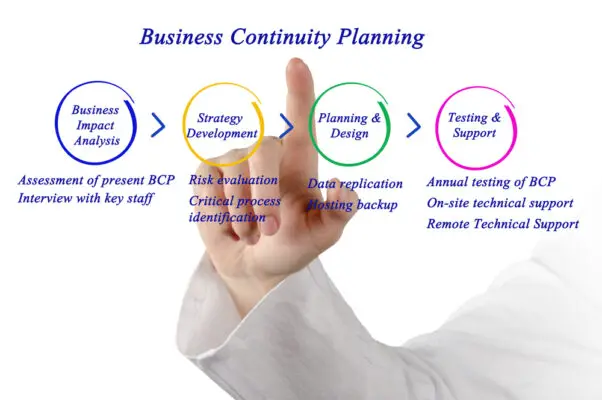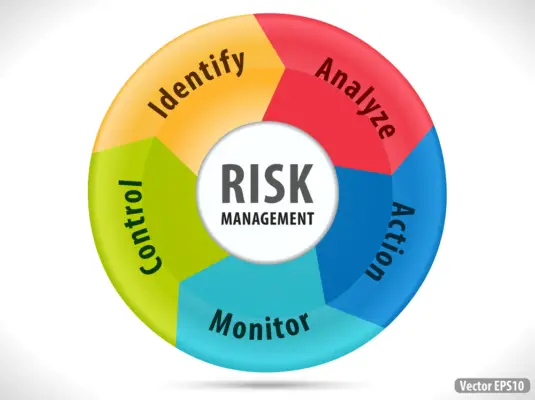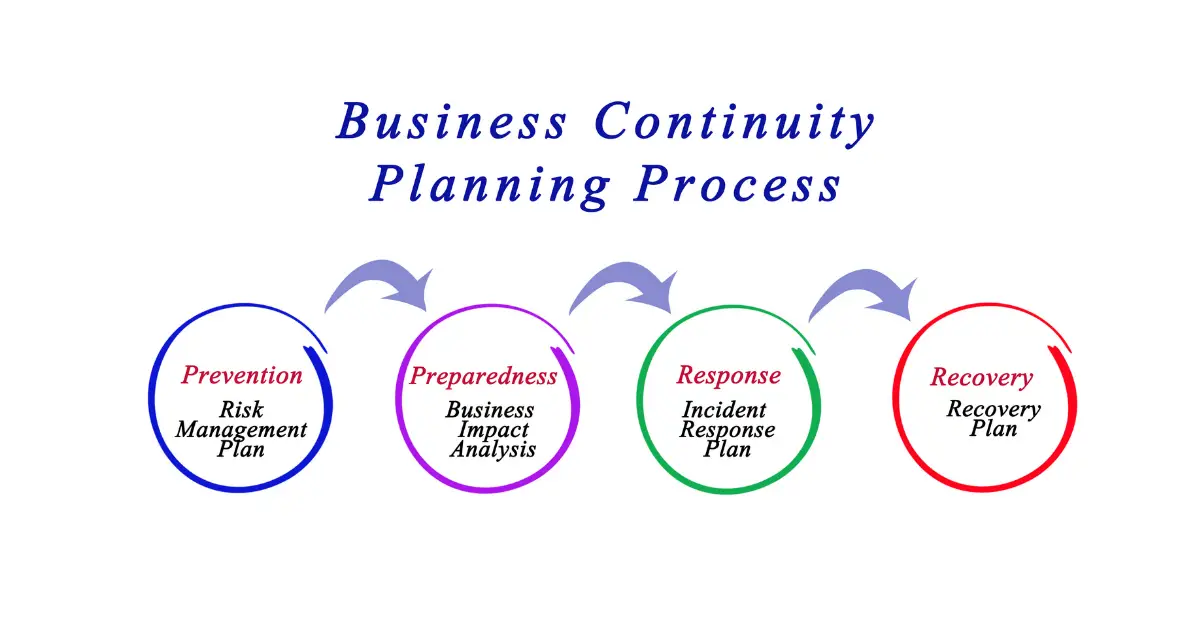A BCP is a comprehensive framework that outlines the procedures, protocols, and strategies necessary to ensure business continuity in the face of unexpected events. At its core, a BCP is designed to help organizations maintain their critical functions and minimize downtime during times of crisis.
Business Continuity Planning (BCP) is a critical aspect of risk management for businesses across all industries. In today’s rapidly changing and unpredictable business landscape, it is essential for companies to be prepared for any potential disruption or disaster that may impact their operations.
This may include natural disasters such as hurricanes or earthquakes, cyber-attacks, power outages, or other unforeseen events that can disrupt normal business operations.
Through the creation of a detailed plan ahead of time, businesses can ensure that they have the resources and capabilities in place to quickly recover from any disruptions and resume normal operations as soon as possible.
In this article, we will explore what exactly a BCP is, why it’s important for businesses to have one in place and the key components involved in creating an effective plan.

Defining Business Continuity Planning
BCP is a set of procedures that an organization puts in place to ensure it can continue operating during and after an emergency or disaster. Such emergencies could include natural disasters like earthquakes or human-made threats such as cyber-attacks.
Small businesses benefit significantly from BCP because they are more vulnerable to disruptions caused by unplanned events. BCP helps small businesses prepare for unexpected situations, minimize downtime, and maintain productivity levels even when there are disruptions.
Moreover, implementing BCP instills confidence in stakeholders such as customers, investors, and employees who see the company as being proactive about their welfare.
Every responsible organization must have a well-crafted business continuity plan that ensures continued operations even during challenging times like pandemics or natural disasters. Business continuity planning involves understanding relevant terms and creating strategies that reduce the impact of potential disruptions.
Small businesses stand to gain immensely from implementing BCPs since they face more significant risks due to limited resources compared to larger organizations. Therefore investing time and resources into developing a robust BCP is essential for any organization serious about minimizing disruptions and maintaining productivity levels even when faced with unforeseen circumstances.
Importance of Risk Management for Businesses
Effective risk management is crucial for businesses to not only mitigate potential losses but also safeguard their reputation and ensure long-term sustainability in an increasingly competitive market.
Risk assessment is the process of identifying, analyzing, and evaluating potential risks that could impact a business’s operations. It involves identifying the likelihood and severity of potential risks and assessing their impact on the organization.
Risk mitigation strategies are used to reduce or eliminate the potential impact of identified risks. These strategies can include implementing controls to prevent or detect risks, transferring risks through insurance or other contractual agreements, accepting certain levels of risk as unavoidable, or avoiding high-risk activities altogether.
The selection of appropriate mitigation strategies depends on a variety of factors such as cost-benefit analysis, regulatory requirements, organizational culture, and stakeholder expectations.
Overall, businesses that prioritize effective risk management are better equipped to identify potential threats and take proactive measures to address them before they escalate into major issues. Through investing in robust risk assessment processes and implementing appropriate mitigation strategies, companies can achieve greater operational resilience and maintain the trust of their stakeholders over time.
In today’s volatile business environment where uncertainty is pervasive, effective risk management has become an essential component for building sustainable organizations capable of weathering any storm.

Key Components of a BCP
The first component of a BCP is contingency planning, which involves identifying potential risks and developing strategies to manage them. This includes assessing the impact of disasters such as fires, floods, or cyberattacks on the organization’s operations.
The second critical component of a BCP is crisis management. This involves establishing clear protocols for responding to emergencies and minimizing their impact on the organization’s operations. Crisis management requires coordination among different departments within an organization, including IT, human resources, and legal teams. Effective crisis management can help mitigate damage caused by unexpected events and minimize downtime.
Communication protocols are another essential component of a BCP. Clear communication channels help ensure that all stakeholders receive timely and accurate information during an emergency. Communication plans should include contact lists for employees, vendors, customers, and other relevant parties.
Regular testing procedures are also necessary to evaluate whether the BCP is effective in practice. Simulating different scenarios can identify gaps in procedures or systems that need improvement before they become critical issues.
Creating a comprehensive business continuity plan involves several critical components: contingency planning; crisis management; communication protocols; and testing procedures. These components work together to ensure that organizations are prepared for unexpected events such as natural disasters or cyber-attacks.
Steps for Creating a Comprehensive BCP
Developing a robust plan for business continuity involves following a series of steps that can help organizations identify potential risks and devise strategies to manage them.
One of the critical steps in creating a comprehensive BCP is conducting a business impact analysis (BIA). This process involves assessing the organization’s critical functions, identifying potential threats that could disrupt those functions, and determining the financial and operational impacts of such disruptions.
Another crucial step in creating an effective BCP is disaster recovery planning. This process focuses specifically on identifying potential disasters or events that could interrupt or shut down critical systems, applications, or services.
Disaster recovery planning involves developing procedures for quickly recovering data and restoring system functionality after an incident occurs. These procedures should include detailed instructions for backup processes, testing protocols to ensure readiness and effectiveness, as well as clearly defined roles and responsibilities for staff members involved in executing recovery plans.
When creating a comprehensive BCP, it is also essential to involve key stakeholders from across the organization in both the planning and execution phases.
This includes senior-level management who may need to approve budgetary allocations for implementing risk mitigation strategies; IT professionals responsible for maintaining systems infrastructure; HR managers who may need to address staffing concerns during crises; and other relevant personnel from across departments within the company.
Involvement of all relevant parties throughout the BCP development process, organizations can ensure that everyone understands their roles and responsibilities during an emergency situation while fostering collaboration across teams toward achieving shared goals of business continuity.
Implementing and Testing Your BCP
BCPs are designed to mitigate the potential impacts of disasters on an organization’s operations, reputation, and financial stability. However, creating a BCP is only the first step. The effectiveness of a BCP depends on how well it is implemented and tested.
One way to test a BCP is through tabletop exercises. These exercises are designed to simulate potential disaster scenarios and evaluate the response of employees and stakeholders. They can be conducted in a conference room setting or remotely using virtual tools, such as video conferencing software. Tabletop exercises allow organizations to identify weaknesses in their BCPs and make necessary revisions before an actual disaster occurs.
Another testing technique involves assessing the effectiveness of recovery strategies after a simulated disaster has occurred. This type of testing examines whether the BCP functions as intended during each phase of incident response: notification, activation, assessment, mitigation, recovery, and restoration.
Implementing and testing your BCP is just as important as creating one in order to ensure its effectiveness during times of crisis. There are various techniques available for testing your plan including tabletop exercises and post-disaster assessments which allow organizations to identify areas for improvement before they experience an actual disaster event.
Ultimately, regularly reviewing your BCP will help you ensure that you are fully prepared for any future disruptions that could impact your business operations or reputation.

Frequently Asked Questions
How much does it cost to implement a BCP for a small business?
The cost of implementing a BCP can vary greatly depending on the size and complexity of the business, as well as the specific risks that need to be addressed.
Small businesses may have limited budgets and resources available for BCP implementation, which can make it challenging to prioritize efforts and ensure that all critical functions are adequately protected. Additionally, there may be logistical challenges in terms of identifying key personnel, developing emergency procedures, and testing the plan regularly.
Despite these challenges, however, implementing a BCP is essential for ensuring the long-term survival of a small business in the face of unexpected disruptions or disasters.
What are some common mistakes businesses make when creating a BCP?
In business, the importance of planning cannot be overstated. However, when it comes to creating a Business Continuity Plan (BCP), many businesses make common mistakes that can hinder their ability to respond effectively in times of crisis or disruption.
One common mistake is failing to identify key business functions and prioritize them appropriately. Without this crucial step, a BCP may not adequately protect critical operations and assets.
Another mistake is neglecting communication plans and protocols, which can lead to confusion and delays in responding to an incident.
Finally, inadequate testing and maintenance of the plan can render it useless when it’s needed most. It’s essential for businesses to recognize these pitfalls and take steps to avoid them in order to ensure the success of their BCP.
How often should a BCP be reviewed and updated?
The importance assessment of a BCP has to be done periodically, usually yearly, or after any significant organizational changes.
A high-level review should take place at least annually to ensure that the plan reflects current business operations and risks.
Any significant changes in company structure, technology, personnel, or external factors such as pandemics or natural disasters may require an immediate update to the plan.
It is crucial to have a regular review process in place, including testing and training exercises for employees, to identify weaknesses in the plan before they become critical during an actual event.
A well-maintained BCP can minimize disruption to business operations and provide assurance for stakeholders that the organization can manage unexpected crises effectively.
Are there any legal requirements for businesses to have a BCP in place?
Legal implications and industry standards dictate that businesses must have a business continuity plan (BCP) in place.
While there may not be a specific legal requirement for every business to have a BCP, certain industries such as finance, healthcare, and government entities are mandated to have one due to regulatory compliance.
However, having a BCP is still essential for all types of organizations to ensure the continuity of operations during unforeseen events such as natural disasters or pandemics.
Industry standards recommend that companies review and update their BCPs regularly to ensure they remain effective in mitigating risks and minimizing disruptions.
Therefore, it is crucial for businesses to prioritize developing and maintaining a comprehensive BCP as part of their risk management strategy.
Can a BCP help a business recover from a cyber attack?
The plan should incorporate components such as cybersecurity insurance and an incident response plan. Cybersecurity insurance can provide financial protection against losses incurred due to data breaches or other cyber attacks.
An incident response plan outlines the steps to take in the event of a cyber attack, including identifying the source of the attack, containing any damage caused by it, and restoring systems and data affected by it.
Having a BCP that includes these elements can help businesses minimize the impact of cyber attacks on their operations and recover more quickly from them.

Conclusion
Business Continuity Planning (BCP) is a crucial component of risk management for businesses. It involves identifying potential threats, assessing their impact, and developing strategies to ensure that the organization can continue its operations in the event of a disruption.
A comprehensive BCP includes key components such as emergency response plans, crisis communication protocols, and data recovery procedures. Creating a BCP requires careful planning and execution. The process involves conducting a business impact analysis to identify critical functions and resources, developing contingency plans for various scenarios, and regularly testing and updating the plan to ensure its effectiveness.
Without a well-designed BCP in place, businesses are vulnerable to financial losses, reputational damage, and even closure. In conclusion, Business Continuity Planning is essential for any organization seeking to mitigate risks associated with disruptions in operations. By identifying potential threats and developing effective strategies to manage them, businesses can improve their resilience in the face of unforeseen events.
While creating a comprehensive BCP may be time-consuming and resource-intensive initially, it ultimately pays off by ensuring that the organization can continue its operations despite disruptions or crises. In essence, implementing an effective BCP is an investment toward safeguarding an organization’s future success.

Chris Ekai is a Risk Management expert with over 10 years of experience in the field. He has a Master’s(MSc) degree in Risk Management from University of Portsmouth and is a CPA and Finance professional. He currently works as a Content Manager at Risk Publishing, writing about Enterprise Risk Management, Business Continuity Management and Project Management.

